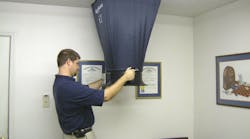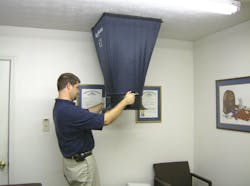Although HVAC System Performance is still a new term to many in our industry, the foundation began more than 20 years ago. I wrote my first article for Contracting Business about this new concept in June 2004, with help from the late Rob Falke, former president of NCI (National Comfort Institute).
The article "Help Customer Comfort with this New System Measurement Procedure" looked at a revolutionary way to explain installed system performance to a customer. Using a simple score also helped contractors prove their workmanship with test results. The procedure was radical because HVAC contractors created the rating based on the existing customer's installation. They didn't rely on yellow labels to express real-world efficiency.
Our family company's first experience with this new procedure was that article's foundation. Little did I know that some of our work would contribute to what would one day become known as HVAC System Performance. Let's look at the beginning of this industry-changing concept, what has changed since then, what remains the same, and how we can continue moving HVAC System Performance forward.
The System Efficiency Ratio (SER) is Born
In July 2003, I attended an NCI Boot Camp in Sheffield Lake, Ohio. Rob Falke told me of a method he'd conceived that would allow HVAC contractors to determine real installed HVAC system performance. There were no laboratory tests or government formulas, just a simple score comparing what a system should do to what it was actually doing.
Rob knew our industry needed a way to better help customers understand the difference between the HVAC equipment and the HVAC system. He called his approach a System Efficiency Ratio™ (SER). It was a simple procedure you could apply to a cooling or heating system to compare system-delivered Btus to manufacturer equipment-rated Btus.
For example, let's say you had a condensing gas furnace rated to deliver 54,000 Btus output. You should get close to 54,000 Btus of output into the building on a perfect installation. Using the SER method, a contractor could measure the delivered heating Btus in the living space and compare them to the furnace Btu output rating. So, if the system measured 27,000 delivered Btus, the SER would be 50% (27,000 ¸ 54,000 = 50%).
From Concept to Real-World Application
In the fall of 2003, our company was in a group of NCI-trained HVAC contractors participating in SER beta testing. NCI created the necessary test forms and procedures to conduct field testing, so we started with a few of our own systems. The idea was to refine the process, work out any issues, and build confidence before we offered this service to our customers.
As a result, we learned a new way to position and differentiate our company. Customers often wanted assurances for the investment they were making. Testing for SER before and after the installation allowed us to prove that the customer got what they paid for and that our work was better than our competitors. Some customers didn't want our best package with SER. We were OK with that because many did.
As we worked SER principles into our daily practices, we discovered a well-performing HVAC system had a tough time maintaining comfortable conditions when installed in a bad building. However, once we knew how the system performed, we could separate HVAC problems from building-related ones, such as air leakage and insulation. This gave us another opportunity to serve customers who wanted a better HVAC system than others could or would provide.
NCI officially released SER in their training in 2005. Hundreds of contractors nationwide began using these principles in their businesses to redefine how customers thought about their HVAC systems. Soon after, NCI created a lead generation process called HeatMaxx™ and CoolMaxx™. These processes enabled technicians to discuss performance issues with customers, gauge interest for further testing, and recommend next steps.
Next, a system certification process was born in 2007 with the release of ComfortMaxx™. It offered contractors a way to certify their systems using a third-party format. ComfortMaxx was then used to certify thousands of HVAC systems nationwide by implementing contractor and utility programs.
Improvements in Technology and Industry Standards
From a technological standpoint, things were very different back in the early days of testing. Test instruments were expensive and/or had limited capabilities. Software for HVAC was rare, and few smartphones were used. Those of us who were testing did our best with what we had.
As we worked SER principles into our daily practices, we discovered a well-performing HVAC system had a tough time maintaining comfortable conditions when installed in a bad building. However, once we knew how the system performed, we could separate HVAC problems from building-related ones, such as air leakage and insulation. This gave us another opportunity to serve customers who wanted a better HVAC system than others could or would provide.
NCI officially released SER in their training in 2005. Hundreds of contractors nationwide began using these principles in their businesses to redefine how customers thought about their HVAC systems. Soon after, NCI created a lead generation process called HeatMaxx™ and CoolMaxx™. These processes enabled technicians to discuss performance issues with customers, gauge interest for further testing, and recommend next steps.
Next, a system certification process was born in 2007 with the release of ComfortMaxx™. It offered contractors a way to certify their systems using a third-party format. ComfortMaxx was then used to certify thousands of HVAC systems nationwide by implementing contractor and utility programs.
Gathering system performance measurements 20 years ago often involved working up a good sweat. We were limited in how we gathered measurements and frequently had to be in multiple places at once. A good psychrometer costs more than $1000, and you typically don't have more than one when testing a system.
We now have affordable and accurate Bluetooth test instruments with fast response speeds. We can also see multiple measurements simultaneously with connected smart test instruments that communicate with apps and software such as MeasureQuick to make testing and data collection easier.
Early adopters of system performance testing had to work through the calculations manually on paper. Software now makes this easier and increases accuracy. While these tools improve testing, understanding how to calculate basic numbers with target ranges for comparison is an essential critical thinking skill. Otherwise, you'll be lost if the calculations don't add up.
For years, contractors who measured performance were outliers who talked about stuff no other HVAC companies mentioned. Now, these principles are part of industry-recognized standards. Rob Falke's revolutionary idea of SER became the foundation for ANSI/ASHRAE Standard 221.
The Song Remains the Same
In the original Contracting Business article, I wrote, "I believe SER ratings have a place in the future of the HVAC industry, but it may take 5, 10, or 15 years for the industry to embrace the idea." So, how are we doing 20 years later?
I'm grateful there's increased awareness, but our industry still has more work. We're finally consistently looking at the airside with more contractors measuring static pressure than ever. The importance of airflow is stressed today more than in years past. Previously, there was a lot of lip service to airflow but very little practical application. This practice has changed in recent years.
With all the advances and progress in understanding the airside of HVAC, we still have a long way to go before HVAC system performance becomes mainstream. Unfortunately, many still sing the song of comfort and efficiency but are off-key in what it takes to deliver on that promise. That's because too many in our industry believe HVAC equipment solves all HVAC system issues. This thought process was wrong back in 2004 and is still wrong today.
Factors currently holding back many HVAC contractors from measuring system performance are the same ones we dealt with 20 years ago. Some of them are that many contractors:
- Don't know how to make it work
- Lack confidence
- Fear the unknown
- Have too much pride and egotism
- Believe it's too much work
- Are unwilling to change
- Can't implement fast enough.
Having an experimental attitude helped my family's business overcome many of the mental obstacles. It forced us to understand how and when to apply the principles to our jobs.
Where Will Another 20 Years Find Us?
Time goes by faster as you get older. Thankfully, there's a new generation embracing HVAC System Performance principles. They get it and will be the ones with the courage to commit and rapidly improve HVAC. Without that commitment, the slow progress of our industry will continue for another 20 years.
When I originally wrote, "Help Customer Comfort with this New System Measurement Procedure," our industry needed a simple way to help homeowners understand the difference between their HVAC equipment and HVAC system. We still do.
I wish Rob were around to see the changes he set in motion. It started with his simple idea to help contractors and their customers understand HVAC system performance. Rob passed away on May 3rd, 2022. In his honor, this day is named National Airhead Day. It's a special day for those in our industry who look beyond the equipment to see the issues affecting installed performance.
Rob dreamed of elevating the HVAC industry from low-paid laborers to well-paid craftsmen. He knew good HVAC companies needed a way to show their superior work and get paid well for doing it. I believe this dream will continue gaining ground, and I can't wait to see what the next 20 years hold. All that's missing is to commit yourself to installing HVAC systems that genuinely perform and then prove it through measurements.
If you're interested in the original Contracting Business article, "Help Customer Comfort with this New System Measurement Procedure," send me an email for the pdf. You won't find it online anymore.
David Richardson serves the HVAC industry as vice president of training for National Comfort Institute, Inc. (NCI). NCI specializes in training focusing on improving, measuring, and verifying HVAC and building performance.
If you're an HVAC contractor or technician interested in measuring HVAC system performance, contact David at ncilink.com/ContactMe. NCI's website, www.nationalcomfortinstitute.com, is full of free information to help you improve your professionalism and strengthen your company.











